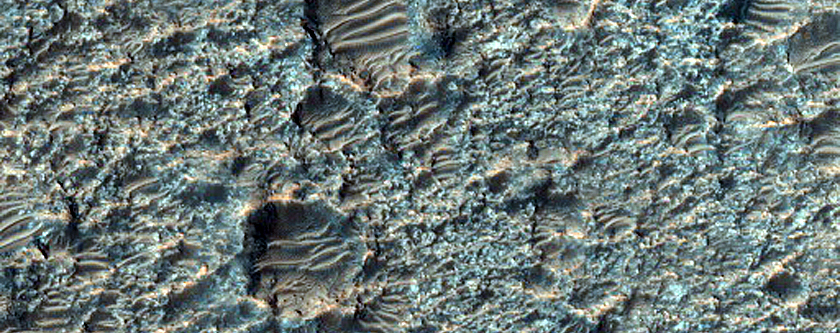The vast southern highlands of Mars
Cool image time! This week the Mars Reconnaissance Orbiter (MRO) science team made available its monthly release of new images taken by the high resolution camera on Mars Reconnaissance Orbiter (MRO). The image above is just a small cropped section from one of those new images, released under the name “Rocky Highlands.” The image on the right is a cropped and reduced section of the full photograph, with the white box indicating the small section above. If you click on either you can see the full resolution uncropped photograph and explore its complex and rough terrain.
What should immediately strike you looking at the small inset section above is the difficulty anyone is going to have traversing this country. There are no flat areas. Every inch seems to be a broken and shattered collection of ridges, pits, craters, or rippled dunes. And the inset above is only a tiny representation of the entire image, all of which shows the same kind of badlands.
This forbidding place is located in the southern highlands of Mars, north of Hellas Basin and south of the transition zone that drops down to the northern lowland plains. The white cross on the map below indicates the image location, with green representing the transition zone, blue the northern plains, and red/orange the southern highlands..

Previously I have highlighted the vastness of the endless northern plains, where some scientists believe an intermittent ocean might have once existed. This particular image gives us taste of the vastness of those southern highlands. Like the northern plains, much of this territory has not yet gotten a close look, with only scattered images so far taken by MRO’s high resolution camera. Like the northern plains we essentially don’t know a lot about what’s there.
Unlike the northern plains, the southern highlands are very rough, and will be a very difficult place to explore, as well illustrated by this particular MRO image. To get either robots or humans into each one of these endless crevasses will probably take centuries, though improved technology, including the use of Martian drones that will be able to fly in its thin atmosphere, could significantly quicken that exploration. Even so, the territory is gigantic, and much of it is as unfriendly as shown in this one little section.
Yet, future colonists are going to have to visit even these badlands, as they might have hidden in them resources unavailable elsewhere on Mars.
The future exploration of the solar system is going be exciting, but it is also going to be very challenging. In fact, it will be the most difficult thing humans will have ever attempted to do. Knowing this should not discourage us, but it should make us conscious of the challenge and the need to face the difficulty with as much realism and brains as possible. We mustn’t trivialize the challenge. Nor should be allow it to defeat us.
On Christmas Eve 1968 three Americans became the first humans to visit another world. What they did to celebrate was unexpected and profound, and will be remembered throughout all human history. Genesis: the Story of Apollo 8, Robert Zimmerman's classic history of humanity's first journey to another world, tells that story, and it is now available as both an ebook and an audiobook, both with a foreword by Valerie Anders and a new introduction by Robert Zimmerman.
The print edition can be purchased at Amazon or from any other book seller. If you want an autographed copy the price is $60 for the hardback and $45 for the paperback, plus $8 shipping for each. Go here for purchasing details. The ebook is available everywhere for $5.99 (before discount) at amazon, or direct from my ebook publisher, ebookit. If you buy it from ebookit you don't support the big tech companies and the author gets a bigger cut much sooner.
The audiobook is also available at all these vendors, and is also free with a 30-day trial membership to Audible.
"Not simply about one mission, [Genesis] is also the history of America's quest for the moon... Zimmerman has done a masterful job of tying disparate events together into a solid account of one of America's greatest human triumphs."--San Antonio Express-News




Wow, that redefines the term “badlands.” Good luck to those Mars colonists.
Somewhat in jest. Someone call up Boston Dynamics and get them to developed a real world version of a large Martian Tripod Walker from H G Wells.
That place is completely Helter-Skelter.
Who left their plastic spoon about dead center in the large image?
Damn tourists!